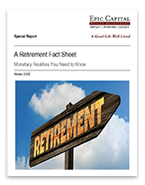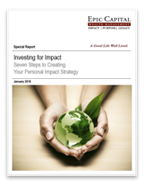What is the 4% Rule for Withdrawals in Retirement?
Dec 13, 2023
 Saving for retirement is not easy, but using your retirement savings wisely can be just as challenging. How much of your savings can you withdraw each year? Withdraw too much and you run the risk of running out of money. Withdraw too little and you may miss out on a more comfortable retirement lifestyle.
Saving for retirement is not easy, but using your retirement savings wisely can be just as challenging. How much of your savings can you withdraw each year? Withdraw too much and you run the risk of running out of money. Withdraw too little and you may miss out on a more comfortable retirement lifestyle.
For more than 25 years, the most common guideline has been the “4% rule,” which suggests that a withdrawal equal to 4% of the initial portfolio value, with annual increases for inflation, is sustainable over a 30-year retirement. This guideline can be helpful in projecting a savings goal and providing a realistic picture of the annual income your savings might provide. For example, a $1 million portfolio could provide $40,000 of income in the first year with inflation-adjusted withdrawals in succeeding years.
The 4% rule has stimulated a great deal of discussion over the years, with some experts saying 4% is too low and others saying it’s too high. The most recent analysis comes from the man who invented it, financial professional William Bengen, who believes the rule has been misunderstood and offers new insights based on new research.
Original research
Bengen first published his findings in 1994, based on analyzing data for retirements beginning in 51 different years, from 1926 to 1976. He considered a hypothetical, conservative portfolio comprising 50% large-cap stocks and 50% intermediate-term Treasury bonds held in a tax-advantaged account and rebalanced annually. A 4% inflation-adjusted withdrawal was the highest sustainable rate in the worst-case scenario — retirement in October 1968, the beginning of a bear market and a long period of high inflation. All other retirement years had higher sustainable rates, some as high as 10% or more.1
Of course, no one can predict the future, which is why Bengen suggested the worst-case scenario as a sustainable rate. He later adjusted it slightly upward to 4.5%, based on a more diverse portfolio comprising 30% large-cap stocks, 20% small-cap stocks, and 50% intermediate-term Treasuries.2
New research
In October 2020, Bengen published new research that attempts to project a sustainable withdrawal rate based on two key factors at the time of retirement: stock market valuation and inflation (annual change in the Consumer Price Index). In theory, when the market is expensive, it has less potential to grow, and sustaining increased withdrawals over time may be more difficult. On the other hand, lower inflation means lower inflation-adjusted withdrawals, allowing a higher initial rate. For example, a $40,000 first-year withdrawal becomes an $84,000 withdrawal after 20 years with a 4% annual inflation increase but just $58,000 with a 2% increase.
To measure market valuation, Bengen used the Shiller CAPE, the cyclically adjusted price-earnings ratio for the S&P 500 index developed by Nobel laureate Robert Shiller. The price-earnings (P/E) ratio of a stock is the share price divided by its earnings per share for the previous 12 months. For example, if a stock is priced at $100 and the earnings per share is $4, the P/E ratio would be 25. The Shiller CAPE divides the total share price of stocks in the S&P 500 index by average inflation-adjusted earnings over 10 years.
5% rule?
Again using historical data — for retirement dates from 1926 to 1990 — Bengen found a clear correlation between market valuation and inflation at the time of retirement and the maximum sustainable withdrawal rate. Historically, rates ranged from as low as 4.5% to as high as 13%, but the scenarios that supported high rates were unusual, with very low market valuations and/or deflation rather than inflation.3
For most of the last 25 years, the United States has experienced high market valuations, and inflation has been low since the Great Recession.4-5 In a high-valuation, low-inflation scenario at the time of retirement, Bengen found that a 5% initial withdrawal rate was sustainable over 30 years.6 While not a big difference from the 4% rule, this suggests retirees could make larger initial withdrawals, particularly in a low-inflation environment.
One caveat is that current market valuation is extremely high: The S&P 500 index had a CAPE of 34.19 at the end of 2020, a level only reached (and exceeded) during the late-1990s dot-com boom and higher than any of the scenarios in Bengen’s research.7 His range for a 5% withdrawal rate is a CAPE of 23 or higher, with inflation between 0% and 2.5%.8 (Inflation was 1.2% in November 2020.)9 Bengen’s research suggests that if market valuation drops near the historical mean of 16.77, a withdrawal rate of 6% might be sustainable as long as inflation is 5% or lower. On the other hand, if valuation remains high and inflation surpasses 2.5%, the maximum sustainable rate might be 4.5%.10
It’s important to keep in mind that these projections are based on historical scenarios and a hypothetical portfolio, and there is no guarantee that your portfolio will perform in a similar manner. Also remember that these calculations are based on annual inflation-adjusted withdrawals, and you might choose not to increase withdrawals in some years or use other criteria to make adjustments, such as market performance.
Although there is no assurance that working with a financial professional will improve investment results, a professional can evaluate your objectives and available resources and help you consider appropriate long-term financial strategies, including your withdrawal strategy.
For more insights and resources, be sure to sign up for our Weekly Market Commentary. Follow our YouTube channel where we regularly post our Epic Market Minute videos. Follow us on LinkedIn, or like us on Facebook. And as always, please don’t hesitate to reach out to a dedicated service professional at Epic Capital.
All investments are subject to market fluctuation, risk, and loss of principal. When sold, investments may be worth more or less than their original cost. U.S. Treasury securities are guaranteed by the federal government as to the timely payment of principal and interest. The principal value of Treasury securities fluctuates with market conditions. If not held to maturity, they could be worth more or less than the original amount paid. Asset allocation and diversification are methods used to help manage investment risk; they do not guarantee a profit or protect against investment loss. Rebalancing involves selling some investments in order to buy others; selling investments in a taxable account could result in a tax liability.
The S&P 500 index is an unmanaged group of securities considered representative of the U.S. stock market in general. The performance of an unmanaged index is not indicative of the performance of any specific investment. Individuals cannot invest directly in an index. Past performance is no guarantee of future results. Actual results will vary.
1-2) Forbes Advisor, October 12, 2020
3-4, 6, 8, 10) Financial Advisor, October 2020
5, 9) U.S. Bureau of Labor Statistics, 2020
7) multpl.com, December 31, 2020
Tags: Certified Financial Planner Charlotte NC, Investing, Personal Finance, Retirement Planning, Retirement Tax Savings, Wealth Building
More Insights
Key Takeaways Volatility came back with a vengeance this week as selling pressure in the mega cap space dragged down the broader market. Counterbalancing weakness in these heavyweight names poses a challenge for the rest of the market. Overbought conditions can also be blamed for the recent weakness. The S&P 500 reached a 14.9% premium … Continue reading “Market Update – Assessing the Technical Damange”
Life insurance can be an excellent tool for charitable giving. Not only does life insurance allow you to make a substantial gift to charity at relatively little cost to you, but you may also benefit from tax rules that apply to gifts of life insurance.
When you think of Social Security, you probably think of retirement. However, Social Security can also provide much-needed income to your family members when you die, making their financial lives easier. Your family members may be eligible to receive survivor benefits if you worked, paid Social Security taxes, and earned enough work credits. The number … Continue reading “Social Security Survivor Benefits”
Information vs. instinct. When it comes to investment choices, many people believe they have a “knack” for choosing good investments. But what exactly is that “knack” based on? The fact is, the choices we make with our assets can be strongly influenced by factors, many of them emotional, that we may not even be aware … Continue reading “Making Investment Choices”
As a business owner, you should carefully consider the advantages of establishing an employer-sponsored retirement plan. Generally, you’re allowed certain tax benefits for establishing an employer-sponsored retirement plan, including a tax credit for establishing the plan and a deduction for contributions you make. In return, however, you’re required to include certain employees in the plan, … Continue reading “Retirement Plans for Small Businesses”
Services
Epic Capital provides the following comprehensive financial planning and investment management services: Learn More >


 Top of Page
Top of Page











